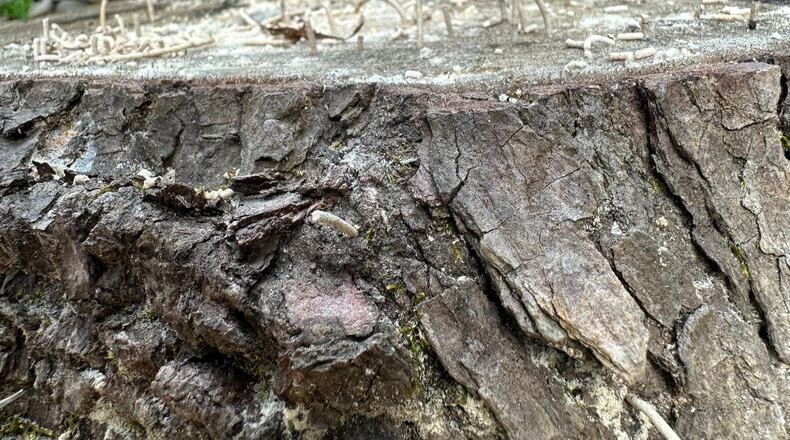Q: I recently had three large sweetgum trees cut down in my backyard. They were very close to a dry creek bed and retaining wall, so I did not choose to have the stumps ground and removed. When I walked by them this morning, I noticed the toothpicks that come from ambrosia beetles. What should I do? I don’t want the nearby magnolia trees to be attacked. Hannah Wise, Sandy Springs
A: Wow, I’ve never seen ambrosia beetles in a stump, but it’s certainly possible. As you know, insecticide is useless to kill them if sprayed after the beetles come into a trunk or stump, but I don’t think you’ll do any harm by leaving everything as is. Ambrosia beetles require a specific humidity for the eggs to hatch in the tree. Your sweetgum stump will surely dry somewhat before next spring, making it inhospitable for further beetle attacks. Other susceptible plants nearby are safe because the beetles will not increase in numbers.
Q: I read your column last week and you said hummingbirds are not attracted to hummingbird houses. If the houses don’t work, what can I do to attract hummingbirds? Fran Irwin, Decatur
A: To attract any animal, you have to go back to the basics: food, shelter and water. Hummingbirds eat nectar, of course, so a couple of nectar feeders would be good. They also eat insects, so flowers that attract pollinators would be good as well. As I wrote last week, hummingbirds construct their own cuplike nests with things like spiderweb silks, lichens, moss and feathers. They love to build nests in trees 10-40 feet high, so you should have one or more of these around as well. Any water source for hummingbirds should be very shallow. This is easy to accomplish by putting stones in your birdbath so hummingbirds can stand on them while they drink so they don’t drown. Hummingbirds are beautiful and fascinating creatures; good luck with yours!
Q: Our rose of Sharon bush has something happening at the end of the branches. It is very sticky when you touch it. Rich Prowse, Canton
A: The sticky stuff is probably honeydew excreted by aphids or scale insects. My bet is that aphids are the culprit. I say this because aphids are very mobile on a plant and would be first to arrive at a place that has lots of sap like the end of branches. On the other hand, scale insects are slower, and I don’t think they’d be able to climb to the ends of branches at this time of spring. A good blast of water every week is usually enough to control them.
Email Walter at georgiagardener@yahoo.com. Listen to his occasional garden comments on “Green and Growing with Ashley Frasca” Saturday mornings on 95.5 WSB. Visit his website, www.walterreeves.com, or join his Facebook page at bit.ly/georgiagardener for his latest tips.
About the Author
The Latest
Featured

